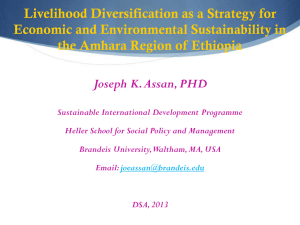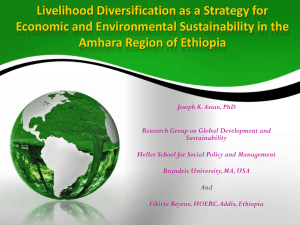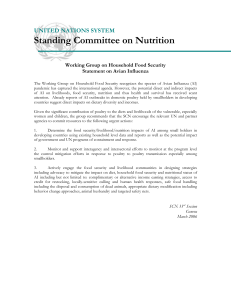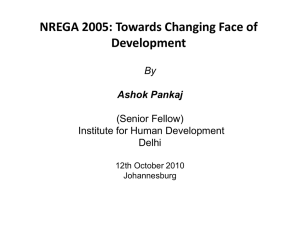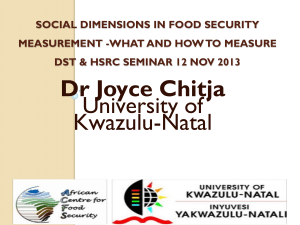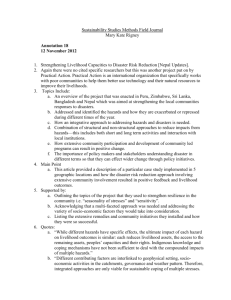Summary of Disaster Response and Disaster Preparedness
advertisement
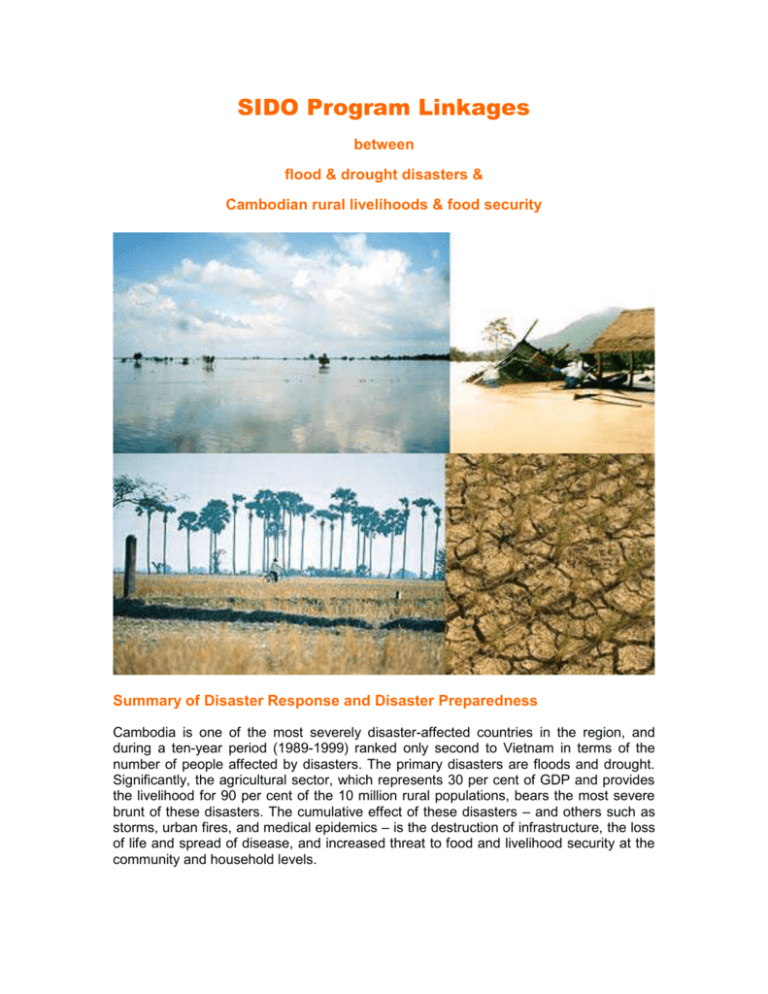
SIDO Program Linkages between flood & drought disasters & Cambodian rural livelihoods & food security Summary of Disaster Response and Disaster Preparedness Cambodia is one of the most severely disaster-affected countries in the region, and during a ten-year period (1989-1999) ranked only second to Vietnam in terms of the number of people affected by disasters. The primary disasters are floods and drought. Significantly, the agricultural sector, which represents 30 per cent of GDP and provides the livelihood for 90 per cent of the 10 million rural populations, bears the most severe brunt of these disasters. The cumulative effect of these disasters – and others such as storms, urban fires, and medical epidemics – is the destruction of infrastructure, the loss of life and spread of disease, and increased threat to food and livelihood security at the community and household levels. The Organization has acts an auxiliary to the Royal Government of Cambodia in disaster response, working closely with the National Committee for Disaster Management (NCDM). Within the Organization, the Disaster Management Department (DMD) is the focal point in disaster response efforts especially in emergency relief assistance, provision of logistical support and management of communication and information to ensure that all actions and measures are accurately and timely provided to those affected by disaster. Disaster Management (Disaster Response and Preparedness) forms one of the four core programmes of the Organization. Aligned with Organization’s Strategy, Disaster Management Policy and reflecting an increased emphasis on longer-term efforts to decreasing people's vulnerability and strengthening their coping capacities to disasters, the programme goal and objectives are: Overall Programme Goal: To improve the quality of life and capacity of the most vulnerable in Cambodia Programme Objectives: 1. The capacity of communities to cope with, and reduce, the impact of disasters is enhanced by the Organization; 2. The capacity of the Organization to develop and successfully implement disaster prevention and mitigation strategies is increased; 3. Efficient and effective Community Based Disaster Management programme implementation is supported through defining more suitable projects and a greater diversification of structural and non-structural micro-solutions. The Disaster Management programme accomplishes its objectives through three integrated components: Community-Based Disaster Preparedness: Since 1998, the CBDP programme has evolved considerably; and forms the basis for Organization preparedness, response and recovery activities. The Organization defines the CBDP programme as “the initiation of a process of community participation, empowerment and problem solving undertaken by a community to prepare for, and respond to, any natural disaster that may affect them”. It involves reducing vulnerabilities (e.g. damaged infrastructure, livelihood & shelter needs) and increasing capacities (i.e. knowledge and skills) to deal with potential natural disasters that often occur. As a community-based grass roots programme, it has been established through village level and the provincial and it is now operational in provinces, with target people directly benefited from CBDP project. Reflecting the above objectives, and based on a series of CBDP evaluations and analyses, the programme will begin a new “remodeling” phase in 2005. This phase will attempt to move the CBDP programme towards an enhanced ability to create disaster resilient communities through a long-term, learning-based approach: with a shift in focus towards the development of actionable community disaster management plans as the central core of the programme – and financial and technical support for the community implementation of small-scale structural and non-structural risk reduction micro-projects – as demonstration activities. Another key development will be the establishment of the Cambodia Disaster Risk Reduction forum, organized by the Organization, and aimed at promoting coordination, exchange of experiences and mainstreaming of Disaster Risk Reduction (DRR) in development planning. Disaster Response: The Organization’s Disaster Response programme is implemented through the network of local authorities located in all 24 provinces and municipalities of Cambodia, in collaboration with the NCDM and various local and international partners. Forming a key component of the Organization’s Community-Based Disaster Management programme, its objective is to enhance the National Society’s capacity to effectively respond natural disasters. It accomplishes this goal through the distribution of food and non-food items by facilitating the evacuation of people affected by disasters to safe areas, and by developing comprehensive disaster relief strategies. The next, SIDO and its partners will continue to work in Disaster Response. It is planning to have many household kits in storage, in part with the assistance of the donors. Flood Early Warning System (EWS): Implemented through the Organization Volunteer network, and collaborating with a variety with diverse our working partners, the projects operate in the villages within provinces along the Lower Mekong Basin (LMB). The aim is to reduce the effects of flooding by promptly obtaining and conveying flood information to the most floodvulnerable communities along the Basin, and developing tools and methods (Community Response Preparedness Plan) that will enable these affected communities to effectively respond to the information disseminated by our LNGO partners. For the long-term planning for the EWS programme has deliberately sought to geographically overlap with many of the CBDP target areas. These ongoing efforts are in keeping with the overall longer-term vision of integrating the two programmes within DMD. Furthermore, as part of the overall Disaster Management strategy, the EWS project will seek to expand its operations into food security issues, in particular in response to drought. Vulnerabilities to disaster impacts related to 9 elements 1. Poor Health Rates of severe illnesses and infections are high, including rates of T.B. and malaria, and a wide range of other forms of severe ill health. A high level of 2% of the population (169,000 people) suffers from a disability such as being an amputee, blindness, deafness, or polio related disability. Nationally in 2002, 170,000 Cambodians, including 12,000 children, were living with HIV/AIDS. This represents 2.7% of the adult labor force. Currently only about 15% of people with HIV/AIDS have access to treatment medication. Only 40% of children aged one to two years have been fully immunized against common diseases and only 57% received Vitamin A supplements. Children aged less than five years suffer from high rates of severe infections. Acute respiratory infections, the leading cause of child mortality, affect 20% of these children and 19% have diarrhea in any two-week period. Under five year old child mortality rates are the highest in Southeast Asia. The infant mortality rate (first year of life) is 96 per thousand births and the less than 5-year age child mortality rate is 138 per thousand births. 2. Prevalent malnutrition among children: Many children are already suffering from malnutrition. Nationally in 2002, 45% of children under five years of age are stunted (chronic malnutrition) 45% are underweight (chronic malnutrition) and 15% are wasted (acute malnutrition). Many children are deficient in micronutrients. Among children under five years 63% suffer anemia (Iron deficiency) and Vitamin A deficiency is very common (Vitamin A is crucial to the body’s immune system function). Iodine deficiencies are also common and are linked to impairment of intellectual development. Anemia (iron deficiency) affects 58% of all women and 68% of pregnant women. Among all women 45% are suffering chronic energy deficiency/ low weight (BMI). This lack of energy makes mothers prone to fatigue, more emotionally vulnerable and negatively affects their capacity to care for children. Vitamin A deficiency is also common among women. 3. Limits in education, knowledge and skills A recent national study of Cambodian adults aged over 15 years found that 62.9% of adults are functionally illiterate (74.2% of women and 52.4% of men). Associated with the widespread lack of education, other studies commonly find that many adults lack knowledge in basic life skills including, health education, and hygiene and sanitation, and mother- childcare and nutrition practices. People’s knowledge is also limited in terms of technical skills to improve crop and livestock husbandry, labor skills and marketing skills. The basic cause of lack of knowledge among rural adults is that they have not had the opportunity to develop their knowledge and skills through accessible adult education and training services. 4. Luck of mass media information services for rural people Mains electricity supply, mains water supply and sewerage are not present in the vast majority of villages. Rural housing is most commonly of temporary or mixed materials and not strongly constructed to meet hazards such as windstorm or flood. Very few households have their own source of safe drinking water and a very small minority own latrines. Only a wealthier minority of rural households own any motorized basic equipment such as motorcycles, hand tractors, rice mills, water pumps or motorboats. Only around 50% of households own oxcarts, and only a small proportion of households have non- motorized boats. Poorer households can lack even the most basic assets such as water jars, hand hoes, bicycles, mosquito nets and shoes and clothing. Many households do not have a store of rice sufficient for the whole years rice needs. In the hungry season (during the wet season) most households have already consumed the rice they have stored for food. A limited amount of fish is stored in the form of prahok, but fruit and vegetables are not usually preserved or stored. Many households have very limited cash savings or gold reserves to help meet needs. Poor people have virtually no cash reserves, even from day to day. Weather reports are restricted to reporting the days weather events in a few provinces. There are no weather forecasts either short term, or monthly, or seasonal, for rainfall, temperature or winds either nationally or by province or by climatic zone within provinces. There is no regular reporting of the Mekong River Commission Mekong Flood Warning System via radio, TV, or print mass media. Related to the above findings there are no services via the mass media providing regular information or forecasting services for events such as floods, droughts, or pest or disease epidemics. There are no seasonal forecast services for crop and livestock production conditions or market trends for these products. There are no regular mass media information and forecast services for fisheries. Regular mass media information services for economic and market news, such as price shifts in commodities and foods, are limited to some print and TV based comparisons of current prices of some products between provinces. There are no forecasts or market analyses. There is no formal regular mass media information and forecast services for labor and employment market trends. There is a lack of mass media information on changes in policy and law. Some reporting on the above issues does occur on an ad hoc basis. Among the very limited existing range of mass media services, there are several problems with the design and quality of content and presentation as follows10: Overall the information services that do exist are low on style and content and are not specifically targeted for communication to rural audiences. Weather or flood related information on TV and radio is presented in a very dull and uninteresting way. The language used is overly technical and not targeted to enable rural people to understand the content. It is reported that this causes rural women to mentally turn off and not listen, despite their interest in what is being discussed, because they can’t understand the language. Scheduling of existing messages is poor, lacking consideration of what times of the day rural people are likely to be listening, and some broadcasts are ad hoc. There are no “signature tune” introductions to alert people that either a routine or emergency weather or flood broadcast is about to be issued. 5. Agricultural Land Agricultural land holdings average only 1.0 hectare per household, 25-33% of households have only 0.01-0.5 hectares per household and 12% are landless. Increasingly, households are becoming landless due to distress sales of land assets. Over 80% of crop production by area is rain fed, dependent on erratic rainfall without irrigation for crop growth. Production of crops is mostly confined to the wet season. An estimated 50% of soils have fertility limitations affecting crop growth. Most rural households do not have formal legal title to their agricultural land. 6. Livestock Cambodian rural households commonly raise livestock including cattle or buffalo, pigs and poultry. However, the number of head owned by households is small, usually 0-2 cattle, 0-2 pigs and around 10 poultry per household. Only slightly more than half of rural households own two mature cattle or buffalo, the requirement for household agricultural draft power. Livestock holdings, including plough animals, must sometimes be sold in distress sale conditions to meet household immediate cash needs. Livestock are at high risk of disease, which leads to high rates of premature mortality. Livestock are often stressed by a seasonal lack of feed and water. Veterinarian and livestock extension services are generally insufficient. 7. Forests and common land areas Cambodian rural people have always exploited common lands around fields, and scrub and forest areas as an important source food and other products and have a great deal of skill and knowledge in this area. The presence of such resources varies a lot between communities. Over-exploitation of forest resources, particularly through commercial logging have damaged the ecology of forests reducing the availability of food, fuel wood for cooking, and other forest products in many areas. Substantial areas of forest have been reduced to far less productive scrublands. The access of rural people to forests has often been blocked by logging security forces. Illegal commercial logging has now been curtailed to an extent. Enforcement of the logging ban has sometimes had the effect of blocking access to forests by rural people, for purposes other than logging. 8. Fisheries Commons fisheries are very important as they provide the staple source of protein in the diet of rural people and a number of products for consumption and sale. Many rural communities are located away from permanent rivers and water bodies and fisheries activities here are restricted to wet season paddy field fisheries. Communities on the major river systems are confronted by decreasing fish stocks through overexploitation, mainly by commercial fishing interests. The operation of large-scale fishing leases has excluded rural people from important reverie fisheries until recently. These leases have now been overturned by law but informal enclosure of fisheries by private interests may still limit access. 9. Household Domestic Assets Mains electricity supply, mains water supply and sewerage are not present in the vast majority of villages. Rural housing is most commonly of temporary or mixed materials and not strongly constructed to meet hazards such as windstorm or flood. Very few households have their own source of safe drinking water and a very small minority own latrines. Only a wealthier minority of rural households own any motorized basic equipment such as motorcycles, hand tractors, rice mills, water pumps or motorboats. Only around 50% of households own oxcarts, and only a small proportion of households have non- motorized boats. Poorer households can lack even the most basic assets such as water jars, hand hoes, bicycles, mosquito nets and shoes and clothing. Many households do not have a store of rice sufficient for the whole years rice needs. In the hungry season (during the wet season) most households have already consumed the rice they have stored for food. A limited amount of fish is stored in the form of prahok, but fruit and vegetables are not usually preserved or stored. Many households have very limited cash savings or gold reserves to help meet needs. Poor people have virtually no cash reserves, even from day to day. The external environment of rural livelihoods is changing • Policy: Many changes to policy and to laws have been made, or are underway, in Cambodia, which aim to reduce poverty and to improve Cambodian rural livelihood security and food security. However, there remain major limitations as the policy and legal framework is still being developed and their problems with a lack of resources, capacity and implementation. • Social: Cambodia is a post-conflict society in the process of recovering at all levels from under-development in the colonial era, the social impacts of war, Khmer Rouge rule and slow recovery up to the time of the UNTAC elections. The development of social/ organizational capacities at the community level has been limited in these conditions. A major progressive social change was the end to war nationwide in 1998 after 30 years of fighting. • Economic: The economy has shown quite strong, but unbalanced national growth since the early 1990’s. Rural poor people have benefited less from growth than wealthy urban people. Challenges remain for the further the development of markets and a major challenge is the capacity of the economy to generate employment. • Political: A number of major progressive political achievements have been made. Government at the national and now commune level is based on democratic elections. Peace was finally achieved in 1998 after 30 years of fighting with the Khmer Rouge. The achievement of good governance has been set as a goal but further progress is still needed in areas such as transparency, accountability and human rights. Government salaries remain inadequate for staff to undertake their work fully and capacity and resource limitations need to be addressed. Problems with corruption have been identified and have been shown to affect many aspects of Cambodian rural people’s livelihoods. • Environmental: A previous section has discussed Cambodia’s vulnerability to climatic change. In addition we can add that Cambodia’s forestry and fisheries resources have been over-exploited mainly by commercial interests. The productivity of these resources has declined substantially and access to forests and fisheries has often been prevented. Changes are underway in the Mekong watershed, which will affect the flow of the river and its flood patterns. • Infrastructure: The country inherited a generally under-developed economic and social infrastructure at independence which was then further damaged by war and then neglected for lack of resources for many years. Infrastructure improvements are required across the board. Some progress has been made, but much remains to be done, particularly at the village and commune level. • Demography: According to the last population Census in 1998 Cambodia now has a population of over 11.4 million which is overwhelmingly rural (84%) and young (42% are children aged 0-14 years). The population growth rate is quite high at 2.49%. The population is women head 54% female and 26% of households. Other Sources *The Evolution of Ideas about Food Security and Livelihoods since the 1970’s A brief history of the inception of household livelihood security During the past several years, much conceptual progress has been made in an understanding of the processes that lead to household food insecurity (Frankenberger 1992). 1970s: A focus on national food supplies as the primary cause of food insecurity with an emphasis supply shortfalls created by production failures In the 1970s, food security was linked mostly to national and global food supplies. The food crisis in Africa in the early 1970s stimulated a major concern on the part of the international donor community regarding supply shortfalls created by production failures due to drought and desert encroachment (Davies et al. 1991). This focus on food supplies as the primary cause of food insecurity was given credence at the 1974 World Food Conference. 1980s: A focus on household food security with an emphasis on food access The limitations of the food supply focus came to light during the food crisis that plagued Africa in the mid-1980s. It became clear that adequate food availability at the national level did not automatically translate into food security at the individual and household levels. Researchers and development practitioners realized that food insecurity occurred in situations where food was available but not accessible because of erosion in people's entitlement to that food (Borton and Shoham 1991). Sen's (1981) theory on food entitlement had a considerable influence on this change in thinking, representing a paradigm shift in the way that famines were conceptualized. Food entitlements of households derive from their own production, income, gathering of wild foods, community support (claims), assets, migration, etc. Thus a number of socio-economic variables have an influence on a household's access to food. In addition, growing food insecurity was viewed as an evolving process where the victims were not passive to its effects. Social anthropologists observed that vulnerable populations exhibited a sequence of responses to economic stress, giving recognition to the importance of behavioral responses and coping mechanisms in food crises (Frankenberger 1992). By the late 1980s, donor organizations, local governments and NGOs began to incorporate socio-economic information in their diagnoses of food insecurity. The household food security approach that evolved in the late 1980s emphasized both availability and stable access to food. Thus, food availability at the national and regional level and stable and sustainable access at the local level were both considered essential to household food security. Interest was centered on understanding food systems, production systems, and other factors that influenced the composition of food supply and a household's access to that supply over time. What was not clear was how nutritional outcomes were factored into food-security deliberations. Early 1990s: A focus on nutritional security with an emphasis on food, health and Mother and childcare 92 Frankenberger T.R., Drinkwater M., & Maxwell D., 2000, Operational zing Household Livelihood Security A Holistic Approach For Addressing Poverty And Vulnerability in FAO 2000, Proceedings from the Forum on Operational zing Sustainable Livelihood Approaches, FAO. Work on the causes of malnutrition demonstrated that food was only one factor in the malnutrition equation, and that in addition to dietary intake and diversity, health and disease, and maternal and child care were also important determinants (UNICEF 1990). Household food security is a necessary but not sufficient condition for nutritional security. Researchers found that there were two main processes that had a bearing on nutritional security. The first determined access to resources of food for different households. This was the path from production or income to food. The second process involved the extent to which the food obtained was subsequently translated into satisfactory nutritional levels (World Bank 1989). A host of health, environmental, and cultural/behavioral factors determine the nutritional benefits of the food consumed; this is the path from food to nutrition (IFAD 1993). This work on nutritional security demonstrated that growth faltering could not necessarily be directly related to a failure in household food security. It shifted the emphasis away from simple assumptions concerned with household access to food, resource base and food systems by demonstrating the influence of health and disease, "caring" capacity, environmental sanitation and the quality and composition of dietary intake on nutritional outcomes. 1990s: A focus on household livelihood security Research carried out in the late 1980s and early 1990s indicated that the focus on food and nutritional security as they were currently conceived needed to be broadened. It was found that food security was but one subset of objectives for poor households, and only one of a whole range of factors that determined how the poor made decisions and spread risk and how they finely balanced competing interests in order to subsist in the short and longer term (Maxwell & Smith 1992). People may choose to go hungry to preserve their assets and future livelihoods. Therefore, it is misleading to treat food security as a fundamental need, independent of wider livelihood considerations. Thus, the evolution of the concepts and issues related to household food and nutritional security led to the development of the concept of household livelihood security. The HLS model adopted by CARE allows for a broader and more comprehensive understanding of the relationships among the political economy of poverty, malnutrition, and the dynamic and complex strategies that the poor use to negotiate survival. The model places particular emphasis on household actions, perceptions and choices, with food understood to be only one of the many priorities. People are constantly being required to balance food procurement against the satisfaction of other basic material and nonmaterial needs (Maxwell & Frankenberger 1992). To summarize, there were three strategic shifts in development thinking that led CARE to the adoption of a livelihood approach: a shift from a concern for regional and national food security to a concern for the food security and nutritional status of households and individuals; a shift from a food-first perspective to a livelihood perspective, which focuses not only on the production of food but also on the ability of households and individuals to procure the additional food they require for an adequate diet; A shift from a materialist perspective on food production to a social perspective, which focuses on the enhancement of people's capacities to secure their own livelihoods (adapted from Maxwell 1996). Definitions and Concepts of Livelihood Security and Food Security A Definition of Livelihood Security “The adequate and sustainable access to income and other resources to enable households to meet basic needs. This includes adequate access to food, potable water, health facilities, educational opportunities, housing, and time for community participation and social integration” (CARE, 2002). “Livelihood insecurity”: This exists where these conditions are not met. That is, where households do not have enough income and resources at all times to meet all the basic needs listed in the definition. Components of livelihood systems: People: their livelihood capabilities. Examples: literacy, health, knowledge, work skills, nutrition. Assets: tangible (resources and stores) and intangible (claims and access), which provide material and social means to make a living. Examples: Tangible assets: house, oxcart, livestock, and agricultural land, store of rice paddy, gold. Intangible assets: forest access, fisheries access, market access to buy and sell products, presence of relatives who will help, security, NGO’s. Livelihood Activities: what people do to make a living. Examples: rice farming, raising pigs, getting forest foods, fishing, sei chnnoul, (casual wage labor) roak sie (small business). Gains or outputs: a living- or what people gain from what they do. Examples: Materialfood, money, Honda Dream. Social- happiness, security, education, knowledge, pride, dignity. Environmental- better soil, more forest, more fisheries, clean water. Livelihood Stresses: “Stresses are pressures typically continuous and cumulative, predictable and distressing”. Examples: seasonal shortages (every year), rising populations or declining forest or fisheries resources. Livelihood Shocks: “Shocks are typically sudden, unpredictable and traumatic”. These livelihood component definitions are taken from Chambers and Conway (1992), “Sustainable Rural Livelihoods: Practical Concepts for the 21st Century, IDS Discussion Paper 296, University of Sussex, UK. Cambodian examples added by this author. Useful information on these concepts, including in Khmer language, are to be found on the new website by the Cambodian Agricultural Research Council (CARD) and the GTZ Food Security and Nutrition Policy Support Project (GTZ FSNPSP ) (www.foodsecurity.gov.kh) Examples: impacts from fires, floods, droughts and disease epidemics, death of a family member, loss of employment, theft, impacts of violent acts, denied access to forest or fisheries areas used in the past. Coping Strategies: The ability to avoid or more usually to withstand and recover from stresses and shocks”. Any definition of livelihood sustainability has to include coping strategies. Two different types of Coping Strategies 1. Adaptive Coping strategies: These coping strategies allow people to cope with stresses or shocks without damaging their livelihood situation significantly in the future. Examples: Spend saved money or gold to buy food. 2. Risky Coping Strategies: These coping strategies allow people to cope with stresses or shocks but with the risk of damaging their livelihood situation significantly in the future. Examples: sell farmland to buy food, sell cattle to buy medicine. Most Recent Developments in the Livelihoods Approach The Livelihoods approach has itself been evolving in recent years. One issue is that being emphasized now is the linkages between household livelihoods and wider society, particularly in terms of relations with social institutions through policies. That is, causes of livelihood insecurity are found in the nature of these relationships and it is recognized that changing these relationships can improve household livelihood security. A second issue has been the growing emphasis placed on the human rights aspects of Livelihoods. People suffering from livelihood insecurity are very often suffering from conditions that are a deprivation of basic human rights. Adequate access to food, shelter health, education and other basic needs for life are basic human rights. Monitoring and Evaluation 1. Organization has a written M&E and reporting system 2. Organization develops indicators of progress in its annual planning process. 3. Organization managers monitor activities according to the planning process and learn from recommendations. 4. Organization regularly reviews and evaluates the effectiveness and impact of its programs. 5. Organization involves the beneficiaries in monitoring and evaluating the quality of service to them. 6. Organization does frequent monitoring of preparedness. 7. Organization uses the Self Assessment as a learning too.

